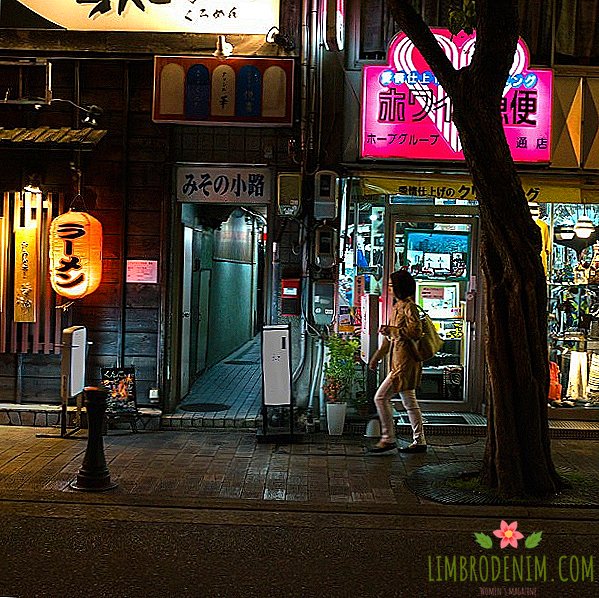Together is not scary: How to make city streets safer for women
Night in the urban tropics of Rio de Janeiro. At nightfall, this city ceases to be friendly to residents. The streets are really scary to walk. Especially if you are a woman. Especially if you are alone. It is almost impossible for men to feel this. When you hear a whistle in the back. When the chill runs down your back and you want to flee. When it is just incredibly scary to return home after sunset. When they say to you: "Be careful!" - but you do not want to live in such a world where you need to be afraid simply because you were born in a woman's body and someone considers you to be the weaker sex.
That evening I walked out into the dark and went to the wrong street. Someone shouted something in my back, but my knowledge of Portuguese did not allow me to understand what it was. By intonation, it was clear that the name is not in the theater. But then a couple of young guys appeared. The girl came up to me herself, told me where it’s better not to go alone in Rio, drove me to the subway, then went out with me at my stop, waited until I caught a taxi, and asked me to unsubscribe to me on Facebook, that I reached to the house. She told me about the Brazilian women's social movement "Vamos juntas?" ("Let's go together?"). It is now very popular in the big cities of Brazil like São Paulo and Rio de Janeiro.
Its creator, a young Brazilian journalist, often returned home after school. She repeatedly noticed that some women travel the same route as she does, but they still travel alone. She created a Facebook page, offering a simple help scheme: if a woman comes home one evening and sees another woman, they just go together, communicate and thus protect each other. Attacks on two women are extremely rare, and even if there is no specific threat of attack, when women walk together, they do not experience fear, feel more comfortable. For two days the page gained 10 thousand likes. Girls began to share stories from life when they were afraid to go out for fear of attack, or were abused by men.
Now at the "Vamos juntas?" Facebook has more than 300,000 likes, the project has a functioning website, and soon there will be an application that collects data about poorly lit streets and areas where women were attacked. His creator has published a book about the movement and spreads the idea of uniting women based on simple human mutual assistance. Having ceased to hope for the state, people begin to believe in themselves and act independently, realizing that in that case the solution to the problem will come faster and be more effective.

Even if there is no specific threat of attack, when women walk together, they are not afraid, feel more comfortable.
I was interested to know what is being done to make it safer for women to appear on the streets. In the United States and most European countries there are special organizations for the protection of women's rights, as well as divisions of international organizations involved in the protection of women's rights. Some of them, such as "Women in the cities", deal directly with the safety of women in public spaces. One of the sensational European initiatives to protect women on the streets is special parking for women in Germany, Austria and Switzerland. They are better lit and closer to busy streets. This initiative was picked up by China and South Korea in the hope of making cities more friendly for women.
But mostly projects for the protection of women on the streets and in public places are concentrated in developing countries. Under the UN, there is the UN Women structure, which deals, in particular, with the issues of protecting women on the streets. A safe environment program for women works in Quito (Ecuador), Cairo (Egypt), New Delhi (India), Kigali (Rwanda), Port Moresby (Papua New Guinea). UN Women works with city mayors, women's communities and organizations, schools, businesses. They are engaged in educational activities, lobbying for the criminalization of sexual discrimination and toughening of punishments for sexual violence, sponsoring women's initiatives. In general, reports on the activities of UN Women are studies of the causes of discrimination, seminar materials with a discussion of the problem, statistics and general conclusions.
But the solution to the problem without "going to the people" is impossible. One of the projects working in this direction is in Cairo - "Harassmap". One of his co-founders worked for a local non-profit organization. She was struck by the harassment that women in Egypt face every day, and concluded that society considers discrimination against women to be something that goes without saying. She, together with her friends and the first volunteers, launched a campaign against discrimination against women: the guys talked to local residents about the rejection of violence, communicated with women, created a page on the social network.
In 2008, the project drew the attention of the Center for Women's Rights in Egypt. After successful anti-discrimination campaigns, organizations began to put pressure on the government to tighten legislation to protect women's rights. Together with UN Women, the Harassmap project in Cairo lobbied for changes in local government regulations that strengthen protection measures against sexual harassment in public places.
Harassmap is now struggling with violence against women in general and is engaged in the security of public spaces. The activists are working to stop the perpetrators from feeling impunity, to consider sexual harassment in society as unacceptable, to tolerate abusive behavior towards the perpetrators, and to be sharply negative. They have two specific areas of activity: educational work with local people and an increase in the number of "street eyes".
"Eyes of the streets" is a term derived from urban design. The international organization Crime Prevention Through Environmental Design creates such a design of urban spaces, which in itself reduces the likelihood of committing crimes. When streets, sidewalks and parks are viewed from the windows and balconies of houses, and there are plenty of lights and seating on the streets, potential offenders understand that their actions will have a lot of witnesses - as a result, the crime rate drops and the pedestrians feel safer. Residents can also increase the number of "eyes" on the streets by arranging various activities in public places: joint dinners, clean-ups, evening games, which people can watch from the windows. Cairo activists are demanding the installation of additional lights on the streets, as well as talking to taxi drivers, owners of restaurants, shops and small shops on the streets of Cairo, so that they also become "eyes of the streets" and, when communicating with customers and customers, have shown that they are very negative about discrimination and promptly reported to the police if they witnessed the violence.
Activists of "Harassmap" claim that, thanks to the activities of their organization, the issues of discrimination and gender-based violence from the category of taboos have passed into the category discussed at the state level. But they still place their hopes on ordinary people, not on the police and politicians. Therefore, activists write articles about violence, communicate with local residents, conduct lessons in schools. They are also working on an interactive discrimination map. Women can anonymously talk about how they faced discrimination, and note where it happened. Visitors to the site can see what incidents occurred in the city, and read the statements of women. Information is transmitted to police officers who can increase surveillance in specific areas, and activists can assess which streets require more attention. Similar projects exist in Bangladesh, Nepal and the Philippines.
One of the other measures to protect women in public spaces is to create places free from men. At one time, in Indian cities, particularly in Mumbai and Delhi, women's trains, women's cars and women's taxis were launched. In India, trains and taxis have become very popular because, in principle, they have made it possible for a woman to move relatively safely around the city. In addition, in society, attitudes toward women's rights began to change gradually: it was assumed that such trains and taxis simply did not mean that women should go somewhere if it was dangerous. The same trains and taxi services exist in the Arab world, in Japan, Malaysia, Indonesia, Brazil, and Mexico. In Russia, separate compartments in long-distance trains did not receive popularity. By itself, this method is far from ideal as it does not solve the problem and does not change the attitude towards it: harassment and harassment remain the norm, and responsibility for violence still rests not with the abuser, but with the victim.
The problem of rape in India is very serious. According to statistics for 2013, 92 rapes occurred daily in the country. In 2012, thousands of rallies were held in the state, demanding the safety of women. The reason was the group rape of a twenty-three year old girl who later died from her injuries. As a result of the rallies, the Indian government made systemic changes to the law, toughening responsibility for sexual harassment, placing voyeurism and stalking into the category of criminal offenses and clarifying the legal concept of consent - the lack of resistance does not mean consent to sex. In some cities, special formulations have been created in courts that try rape cases on an expedited basis. Hot lines for victims of violence have been launched in a number of cities.
But the streets of the big cities of India are still unsafe. Rape is often committed when women go to public toilets that close after sunset, and toilets are uncomfortable, it’s scary to be in them. During my travels in India, like most local women, I felt relatively safe only in supermarkets and subways. The infrastructure of Indian cities requires significant improvements.
In the field of urbanism in India, there is a small but productive project "Let's Color", which the paint manufacturer launched in India and other countries six years ago. The company, together with the locals, is painting houses in whole districts, making the space more comfortable and clean. How does painting the walls of houses affect the safety of the streets? In criminology there is a theory of broken windows: according to her, the reason for the crime situation is in connivance and a calm attitude towards minor disturbances of order. If we do not pay attention to littered streets, fights, ticketless transportation and broken lanterns, we ourselves condemn ourselves to a more criminogenic society. People become less sensitive to violations of law and order, in principle, the norms of the law in consciousness due to impunity begin to blur. "Let's Color" act in accordance with the conclusions of this theory: they improve courtyards and districts, take out the rubbish from the streets and paint the shabby walls of houses in beautiful bright colors.
Also, after a loud incident in India, private initiatives intensified in the country. Indian developers have created an application for smartphones VithU. In the event of an emergency, simply double-click on the application icon, and the smartphone will call the phone numbers of friends or family members specified during registration and send them the current location of the smartphone owner. In Russia, a fundraiser was launched for a similar Nimb project - a ring with a built-in alarm button that synchronizes with a smartphone. The measures of this and other similar projects are aimed at minimizing the consequences of an attack.

If we do not pay attention to littered streets and broken lanterns, we ourselves condemn ourselves to existence in a more criminogenic society.
In Russia, public spaces are also still unsafe for women. According to official statistics from the Ministry of Internal Affairs, in 2016, from January to May, 1,683 rapes and attempted rape were recorded in Russia - and these are only official figures that do not take into account how many women do not go to the police after the attacks. Residents of cities in Russia, too, unite to help each other. In Moscow, since 2013, there is the project “Brother for Sister”, the purpose of which is to ensure the safety of women in the dark. Girls can write to the project coordinators with a request to meet them at night at the subway or train and carry them home, and they connect them with volunteers. Male volunteers are pre-checked by the coordinators. Later, the girl can contact the volunteer directly. There are similar projects in Volgograd, Krasnodar, Yekaterinburg and some other cities.
Another project involved in ensuring the safety of women on the streets operated in Petrozavodsk and three other cities in different countries with the support of the UN and the aforementioned organization Women in the Cities. The project was completed in 2011.
The problem of women's safety in Russia is still not actively discussed. But this does not mean that it is not there - the project # ЯНЭЯisDayut showed how great it is. Should Russian women wait for changes in the infrastructure of cities or is it better to create the conditions for their own safety? Are we strong enough not to be afraid and act? Are you ready to overcome doubts and embarrassment in order to walk up the street to another woman and say: “Let's go together,” instead of looking around and speeding up your steps? It would be desirable that these questions quickly become rhetorical.
Photo: 1, 2, 3 via Flickr, HBpictures - stock.adobe.com








